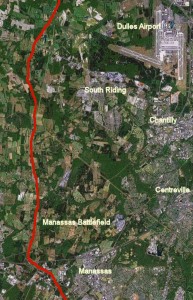Battle lines are forming over the north-south transportation corridor in Northern Virginia. Backers say it would serve a growing population and stimulate economic development. Foes say the state has more urgent priorities for spending $1 billion or more.

Red line shows approximate route of the North-South Corridor where it runs through the Manassas Battlefield and extensive farmland. (Click map for more legible image.)
by James A. Bacon
Northern Virginia, we hear over and over, is one of the most congested regions in the nation – perhaps the most congested. Even with new mega-projects coming on line like interstate express lanes and the rail-to-Dulles Metro service, the list of transportation needs seems endless. Most improvements under consideration are designed to ameliorate the traffic gridlock that grips the region now. But one particular cluster of projects zooming through the bureaucratic approval process is designed to address traffic congestion that is forecast to be a problem… in 2040.
In 2011, the Commonwealth Transportation Board (CTB) added the so-called North-South Corridor west of Dulles International Airport to its list of strategically important Corridors of Statewide Significance (CoSS), a designation that gives priority funding to projects within the corridor. It was the first time the CTB had added a new corridor not based upon an existing Interstate or rail line. Fast-tracking the project, the McDonnell administration has held public hearings and plans to present findings regarding a specific route and the cost to build a limited access highway this month.
Backers say Northern Virginia needs a north-south corridor – in particular, a limited access highway known in different configurations as the Tri-County Parkway or Bi-County Parkway — to accommodate the region’s fast-growing population and employment, and also to promote freight cargo-related economic development around Dulles International Airport.
“If you look at the population projections of the [Metropolitan Washington Council of Governments] and the Commonwealth of Virginia, you see a major percentage of future growth in Northern Virginia does occur in this corridor and points west,” says Bob Chase, president of the Northern Virginia Transportation Alliance. “Loudoun and Prince William counties will add a couple hundred thousand people over the next 20 to 30 years.”
But skeptics describe the project as a wildly speculative endeavor that might enrich big landowners whose properties are made accessible by the new highway but otherwise do little to address Northern Virginia’s most pressing concerns. In particular, they say, Northern Virginia growth patterns in the 1990s and 2000s have little predictive value for the future.
“The world has changed. Our population is older and is downsizing their homes. Empty nesters and younger workers want to live closer to jobs and transit, and in more urban places,” says Stewart Schwartz, executive director of the Coalition for Smarter Growth (CSG). “Moreover, the region has far more pressing needs serving existing population centers and addressing existing congestion. We need every dollar to fix existing commuter routes like I-66.”
Funding the north-south corridor, says Schwartz, would be “a misallocation of scarce resources.”
Only a year ago, the point seemed moot. Virginia was running out of state funds for new highway construction projects. But the north-south corridor controversy is sure to flare now that the General Assembly and Governor Bob McDonnell are close to approving a restructuring of transportation taxes that is expected to raise $800 million a year statewide for new transportation spending. Projects that had been pushed to the back shelves suddenly look fundable.
$2 Billion dollar project?
Northern Virginia’s major transportation arteries – Interstate 95, Interstate 66 and the Dulles Toll Road – all converge on the I-495 Capital Beltway or Washington, D.C., itself. Over the decades, population growth, job growth and development have followed those pathways out from the urban core. North-south arterials have been built to connect that growth, including the Fairfax County Parkway in the center of Fairfax County, and Rt. 28, farther west. The North-South corridor would represent a fourth such arterial but it would serve hypothetical future transportation demand, not a demand that exists at present.
Although the final plan has not yet been published, the North-South corridor likely will follow a path something like this: Read more.


